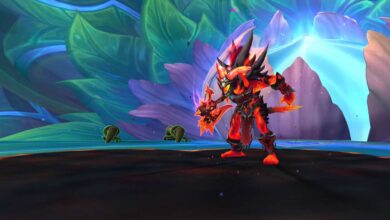
Counter-Strike: Global Offensive (CS:GO) is a renowned first-person shooter game that has garnered a massive following since its release. One of the critical elements that contributes to the game’s allure is the variety of weapon skins available, with each skin having its own unique design, rarity, and significance in the gaming community. Among these skins, the M4A1-S | Hyper Beast stands out as an iconic and highly sought-after skin that has left a significant impact on CS:GO culture and the gaming scene in general. In this article, we will explore the birth, evolution, popularity, and rarity of the skin, its influence on CS:GO culture, its significance in eSports, and conclude with its lasting legacy within the gaming world.
The Birth
The skin made its debut in CS:GO during the Chroma 2 Case release in March 2015. Created by the talented artist Brock Hofer, the skin immediately captured the attention of the CS:GO community with its striking and mesmerizing design. The artwork features a surreal combination of vibrant colors and intricate patterns that form a beastly creature, resembling something out of a vivid hallucination. The skin quickly gained popularity among players, both for its aesthetic appeal and the high-quality design execution. It showcased Valve’s commitment to collaborating with talented artists to produce visually stunning content for the game, marking the beginning of its journey as an emblematic skin.
Evolution
In the months following its introduction, the skin continued to grow in popularity, becoming one of the most coveted skins in CS:GO. Players not only appreciated its eye-catching appearance but also recognized its potential as a valuable item in the game’s trading scene. As a result, the skin gained prominence in the Steam Community Market, with its price surging due to its rarity and high demand. This escalating interest led to an increased interest in skins and motivated Valve to collaborate with more artists to create unique and attractive designs, further enriching the CS:GO experience for players.
Popularity and Trading Scene
The skin’s popularity continued to soar, transforming it into a symbol of status and prestige within the CS:GO community. Players sought after this skin to display their in-game wealth and individual style. As its popularity grew, so did the skin’s value in the trading scene. The rarity of the skin, combined with its stunning aesthetics, made it a highly sought-after item in skin trading circles. Many players saw it not only as a cosmetic item but also as a form of investment, as the value of the skin increased over time, making it a lucrative asset for traders and collectors alike.
The skin’s demand also gave rise to skin trading platforms outside of Steam’s official marketplace, creating a vibrant and active secondary market. Skins were bought, sold, and traded on various websites, fostering a unique and dynamic economy that extended the longevity of the game’s appeal. Consequently, this thriving trading scene has significantly contributed to the sustained popularity of CS:GO even years after its initial release.
Impact on CS:GO Culture

The skin’s profound impact on CS:GO culture cannot be overstated. As the skin gained widespread recognition and became synonymous with the game itself, it influenced the way players perceived and engaged with weapon skins. Players started to view skins not merely as cosmetic upgrades but as an integral part of their gaming identity. Sporting the skin became a statement, a way for players to express their personality and taste within the game.
Moreover, the success of the skin paved the way for the introduction of more visually striking and artistic designs in subsequent CS:GO updates. The skin raised the bar for skin quality, encouraging Valve to collaborate with renowned artists, continually pushing the boundaries of creativity and innovation. As a result, the game’s skin collection became more diverse, appealing to a wider range of players and driving CS:GO’s continued popularity.
Rarity and Rarity Factors
The allure of the skin lies not only in its exceptional design but also in its rarity. Rarity is a crucial factor that drives the value and demand for skins in CS:GO. The skin’s initial release in the Chroma 2 Case was limited, making it relatively scarce compared to other skins. As a result, the skin quickly became a sought-after item among players and collectors alike, leading to its elevated price on the market.
Several factors contribute to the rarity of skins in CS:GO, including the case they are featured in, the frequency of their drop rates, and the quality tiers assigned to them (e.g., Consumer Grade, Industrial Grade, Covert, etc.). The belongs to the Covert (red) rarity tier, which designates it as one of the rarest and most valuable skins in the game.
In eSports
Beyond its impact on the trading and cosmetic aspects of the game, the skin has also found its way into the realm of eSports. Professional players and teams have been seen using the skin during competitive matches, further cementing its status as an iconic CS:GO skin. Fans watching these tournaments often aspire to own the same skins as their favorite players, contributing to the growing interest in the skins featured in eSports events.
Moreover, the popularity of skins has led to the inclusion of skin showcases and collections in various eSports events. This integration not only adds to the visual spectacle of the competitions but also serves as a testament to the significance of skins in the CS:GO culture.
Conclusion
The skin’s journey from its birth in the Chroma 2 Case to its widespread popularity and impact on CS:GO culture showcases the powerful influence that cosmetic items can have within gaming communities. Its striking design, combined with its rarity, has made it an emblematic symbol of status and individuality among players. Furthermore, its role in the vibrant skin trading scene and its appearance in professional eSports tournaments have solidified its place in the history of Counter-Strike: Global Offensive.
As CS:GO continues to evolve and expand, the legacy of the skin will remain as a testament to the creative possibilities that exist within the gaming world. It serves as a reminder that art, even in the form of virtual skins, can leave a lasting impact on a gaming community, shaping the way players engage with and cherish their virtual experiences.



